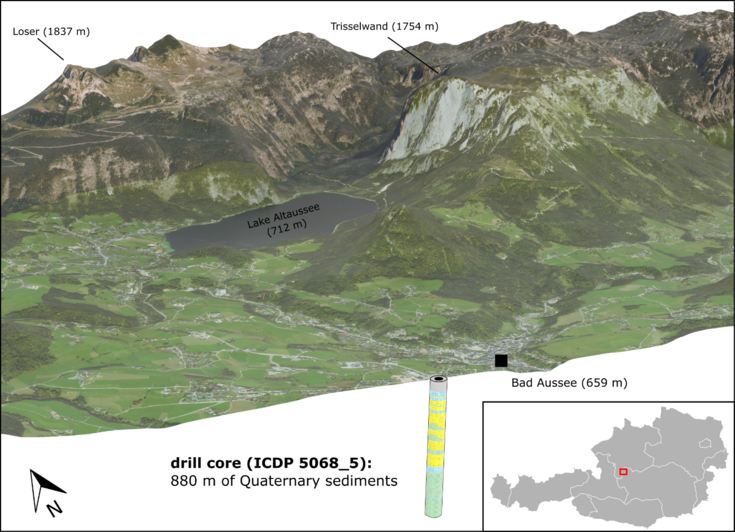Reconstructing the Quaternary evolution of the overdeepened Bad Aussee Basin (Styria, Austria) by analyzing the sedimentary record of an 880 m long drill core
SUPERVISOR: Markus FIEBIG
PROJECT ASSIGNED TO: Clemens SCHMALFUSS
Overdeepened valleys and basins were formed in the Alps and their foreland as a consequence of Quaternary glaciations. The exact formation mechanisms of these structures, which usually have the shape of elongate troughs, are unknown, but it is assumed that pressurized subglacial meltwater plays an important role. Pre-existing tectonic structures, weak bedrock lithologies and ice confluence are often observed in association with overdeepened valleys. Understanding glacial overdeepenings is essential for several fields of applied geology like tunnel construction or groundwater and geothermal exploration. Furthermore, these structures are filled with often hundreds of meters of sediments eroded from the Alps making them excellent archives of Alpine environmental and glacial history.
The goal of the ICDP - DOVE (International Continental Scientific Drilling Program - Drilling Overdeepened Alpine Valleys) research project is to improve our understanding of overdeepened valleys in the Alps and answer questions regarding the timing and extent of Quaternary glaciations and their impact on landscape evolution by a detailed investigation of drill cores. In an international collaborative effort of several partners in Austria, Germany and Switzerland, phase 1 of the project is focused on the northern front of the Alps and their foreland and will target five drill cores from complementing sites.
My PhD research will primarily focus on the investigation of a core from the basin of Bad Aussee (Styria), which recovered 880 m of Quaternary sediments (ICDP-5068_5). Geophysical data show a narrow, up to 1100 m deep structure with a highly unusual shape for an overdeepened basin (‘Hole of Bad Aussee’). A possible explanation for this feature is the dissolution of a large salt body under subglacial conditions resulting in the formation and subsequent filling of a lake. The lower part of the sedimentary succession of the core consists of fine sediments interrupted by coarser layers. The exact age of the overdeepened structure is unknown. My investigations will help answer the following key research questions:
- How is the infill of the overdeepening of Bad Aussee structured and subdivided? Can its formation and infill be attributed to Alpine glaciation events?
- Where does the material of the infill of the hole of Bad Aussee come from? Does physical dating provide information about erosion- and sedimentation rates over time?
- How did the assumed underlying salt rock influence the formation and shape of the overdeepened structure?
- Is it possible to see differences in the time frame of formation and infill of the investigated basins in DOVE phase 1?
A detailed sedimentological core description and a wide range of investigations of the core material (e.g. grain size, total organic carbon, total inorganic carbon) will help address these questions. To obtain depositional ages of the sediments, luminescence and terrestrial cosmogenic nuclide (TCN) dating methods will be applied. In addition, pollen analysis and magnetostratigraphy may help provide further age constraints. Also, a new geophysical survey is planned to better resolve the geometry of the structure. Comparing the results with the other drill cores investigated during the DOVE project will help reconstructing the Quaternary glaciation history of the Alps and identifying regional differences.

Fig. 1: 3D-visualisation of the location of the ICDP 5068_5 drill core close to Bad Aussee, Styria (Source of orthophoto: www.geoland.at, source of digital elevation model: gis.stmk.gv.at)

Fig. 2: Drill core succession from 758 m (bottom left) to 751 m (top right) depth interpreted as mass movement deposits
